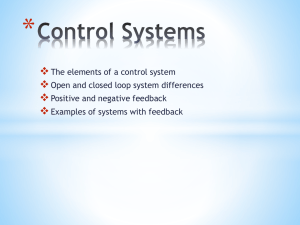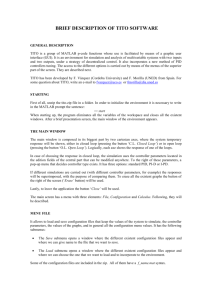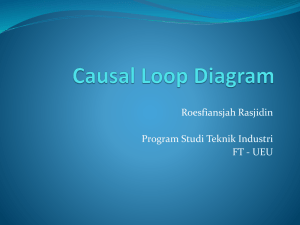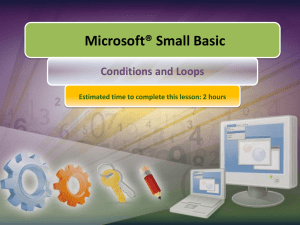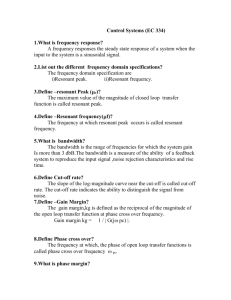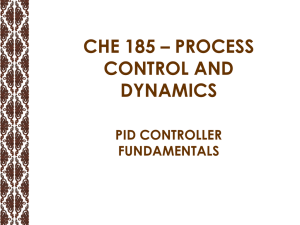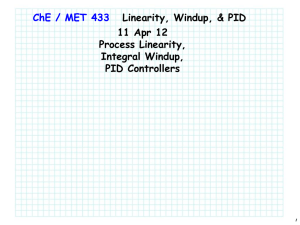Override control to protect a boiler system
advertisement
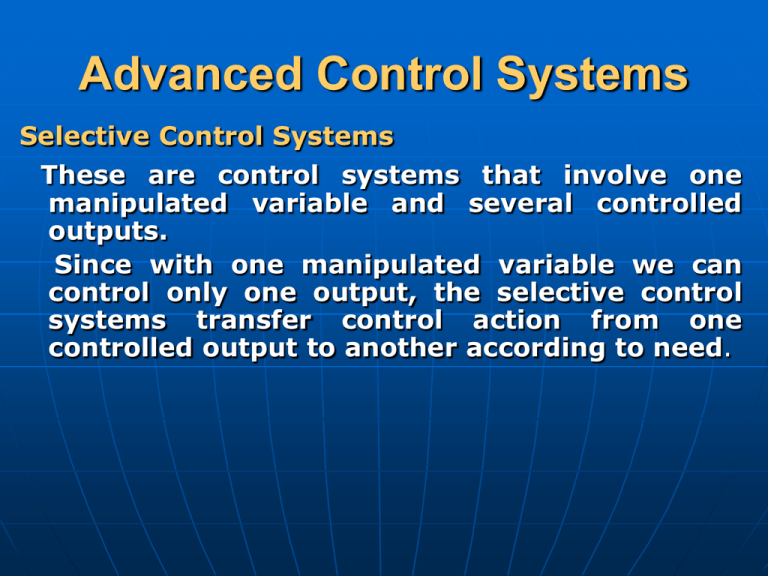
Advanced Control Systems Selective Control Systems These are control systems that involve one manipulated variable and several controlled outputs. Since with one manipulated variable we can control only one output, the selective control systems transfer control action from one controlled output to another according to need. Override Control During the normal operation of a plant or during its startup or shutdown it is possible that dangerous situations may arise which may lead to destruction of equipment and operating personnel. In such cases it is necessary to change from the normal control action and attempt to prevent a process variable from exceeding an allowable upper or lower limit. This can be achieved through the use of special types of switches: • HSS (high selector switch):- whenever a variable should not exceed an upper limit. • LSS (low selector switch); to prevent a process variable from exceeding a lower limit. Override Control Override control to protect a boiler system Steam Discharge Line Loop 1 Loop 2 PT Boiler LT LC LSS PC Water Steam pressure in the boiler is controlled through the use of a pressure control loop on the discharge line (Loop 1). Water level in the boiler should not fall below a lower limit necessary to keep the heating coil immersed in water thus preventing its burning out. Therefore an override control system using an LSS is used. If liquid level falls below the allowable limit, the LSS switches the control action from pressure control to level control (Loop 2) whenever discharge pressure reaches the upper limit. An override control with HSS is used to prevent discharge pressure from exceeding an upper limit. It transfers control action from the flow control to the pressure control loop (Loop 2). F C HSS S Loop 2 C P C PT Loop 1 FT Gas in Gas out Motor Compressor Override control to protect a compressor ii- Auctioneering Control Hot Spot Reactants Temperature Products TT TT TT TT TT Auctioneering system 0 L T C Coolant Auctioneering control system for a tubular catalytic reactor Split Range Control The split range configuration has one measurement only (controlled output) and more than one manipulated variable. Valve stem position Open P C V2 Closed PT Reactants 3 Reactor V1 V1 Products V2 Reaction system with split-range control 15 6 9 Controller’s output signal psi Controller’s output signal Valve, V1 Stem position Valve, V2 Stem position 3 psig Open Closed 9 psig Open Open 15 psig Closed Open Adaptive Control It is a control system which can adjust its parameters automatically to compensate for variations in the characteristics of the process it controls Why do we need adaptive controller in Chemical Processes? Most chemical processes are nonlinear, linearized models that are used to design linear controllers depend on the particular steady state around which the process is linearized. As desired steady state operation of a process changes the best values of the controller parameters change. Most of the chemical processes are non-stationary i.e. their characteristics change with time e.g. decay of catalyst activity in a reactor and the decrease of the overall heat transfer coefficient in a heat exchanger due to the fouling. This change leads to deterioration in the performance of the linear controller which was designed using some nominal values for the process parameters. . Programmed or Scheduled Adaptive Control New values of controller parameters Adjustment mechanism Auxiliary measurements Outer Loop Set Point Controller Process Controlled Output Inner Loop Suppose the process is well known i.e. an adequate mathematical model for it is available. If there is an auxiliary process variable which correlates well with the changes in process dynamics, by measuring the value of the auxiliary variable we can program the adaptation of a programmed adaptive control system. The figure shows the block diagram of a programmed adaptive control system. Example : Programmed Adaptive Control of a Combustion System Consider a burner where the fuel/air ratio is kept at its optimal value to achieve highest combustion efficiency. This is maintained through a ratio control mechanism shown in the figure below. Fuel Fuel FT FT Desired ratio Ratio Adjustment Desired ratio FC FC TT FT Air FT Air Optimal value of F/A depends on the process conditions (e.g. air temperature). If we know how (F/A)op changes with Tair for max. efficiency we can use programmed adaptive control system as shown in figure below.


